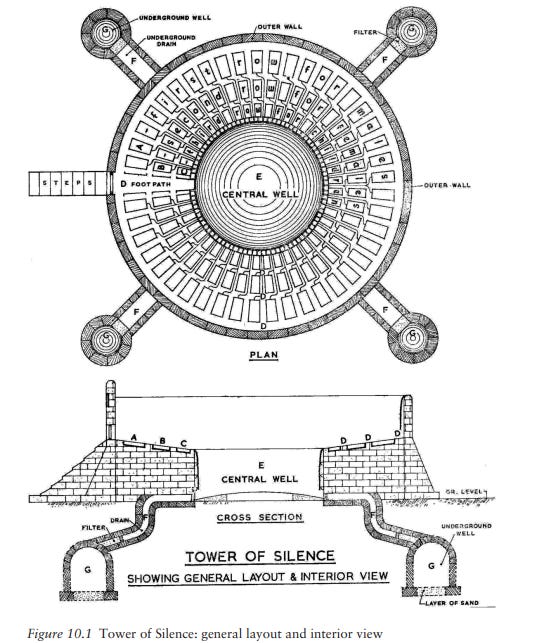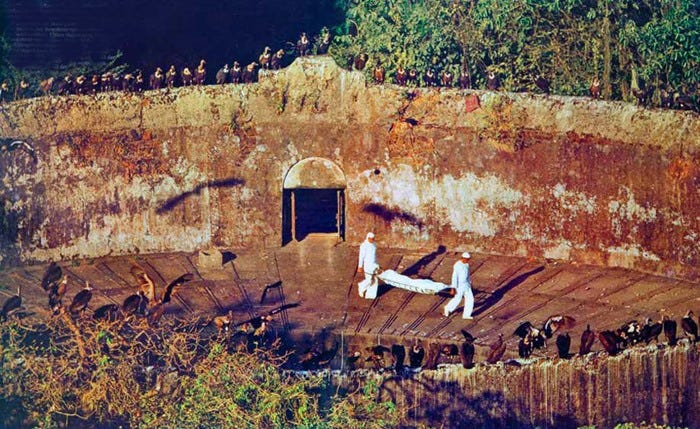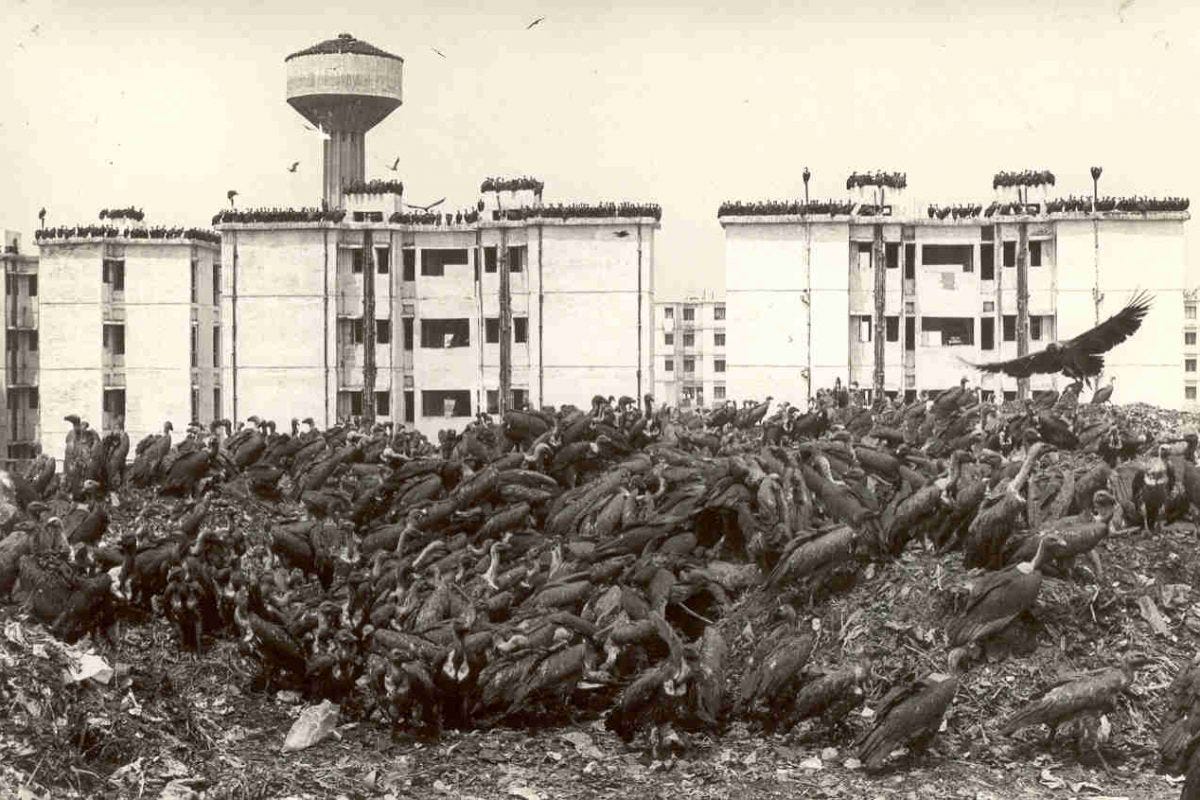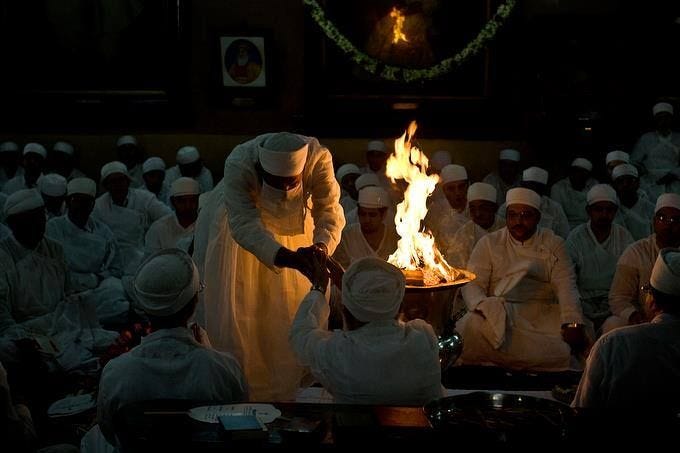How Diclofenac is killing Zoroastrianism
How Diclofenac is killing Zoroastrianism
The Indian Vulture Crisis, sky burials and the end of the oldest religion?
Only after I had lent a shoulder to three colleagues and carried Framroze up the hill, depositing him on the topmost step of one of the Towers; only after I had turned my back on him, and whipped the sheet off his naked corpulent body, clapping my hands loudly three times—which was the signal to let mourners gathered in the small temple garden know that the consecrated body of my father had been offered to the vultures to devour, that they should commence their prayers for the effortless transmission of his soul; only after all that was over and done with, and the mourners had left, and a deep silence had descended once again on the Towers, only then did the floodgates of my grief open, and I cried bitterly for my father whom I would never see again.
- Chronicle of a Corpse Bearer, Cyrus Mistry
He told this tale just as the ancients told it, he spoke the hidden mysteries of the righteous. One day it was he told this story to us, strung beautifully the pearls of past events. For that dastur who told this tale to me may goodness be his ever-present friend. I shall recount the story in his words, I’ll tell the secret deeds of Zoroastrians…
- The Qesse-ye Sanjan
No-one is entirely sure when the Zoroastrians first arrived in India. The ancient religion appears to us in hints through Herodotus, the Avesta, the Gathas, Strabo and in the material remains of ancient temples and inscribed bricks. Its most outstanding and noteworthy feature, recorded and commented on by everyone, is its insistence on feeding the dead to vultures and raptors, rather than fire or earth by cremation or burial. Even today in Mumbai, adherents of Zoroaster still maintain this tradition, relying on flocks of birds to help shepherd their souls away from this polluting world. The official narrative is that the Zoroastrians were forced out of Persia by the early Islamic invasions of the 630’s AD. Flush with success, the sons of Mohammed cleansed the land of pagans, helping set in motion forces which ended the British Raj. India’s ‘Parsis’, as they came to be known, punched way above their weight in commerce, politics, law, academia and in the military, birthing a prosperous middle class. Despite this story of exile and success, the Parsi population of India is dying, and with it a faith stretching back into the mists of antiquity. One reason for this has been the shocking and rapid decline of vultures across the subcontinent, a crisis of such magnitude it has precipitated the return of anthrax. With a birth replacement rate of just 0.8 children per couple, the Parsis and vultures look set to go into that long night quietly, hand-in-hand. This is their story.
The Towers of Silence
Sky burials are likely one of mankind’s oldest ways to dispose of the dead. To be eaten by another animal, even one as symbolic as a bird, leaves almost no trace in the archaeological record, and as such we have no way of knowing when the practice started. Suggestions from the Neolithic site of Catalhoyuk point towards vultures and birds of prey possibly eating some of the dead, and in places like Tibet sky burials are a practical as well as spiritual necessity, the ground being too cold to dig. People often underestimate how much fuel is needed to burn a body, roughly 500kg of dry wood.
Vultures in particular are the key ingredient for a successful sky burial, since they have the capacity to strip a human body in minutes and have no trouble digesting bones. For Zoroastrians this is crucial. A key tenet of their faith is that the decaying human body is polluting, and even to use the holy substances of fire or water to get rid of it would be unacceptable. Thus sky burials free the soul from the flesh without tainting the earth.
Simply leaving corpses lying around would also be a violation of the ground, so the Zoroastrians developed a systematic and ritualised method for sky burials, one which reached its apogee in parts of India. The Towers of Silence. The towers are a physical, circular building which shield the act of the body being devoured from public view. How this practice evolved is unknown, with ancient sources referencing the use of dogs, trenches, covering half-eaten corpses with wax and the use of ossuaries to keep bones for eternity. Most likely the use of towers developed during the Sassanid period (220’s-650’s AD), but we have very little to go on here - the archaeology of Zoroastrianism might be the poorest of all the world’s major religions, another one of those topics few scholars care about.
Contemporary Towers of Silence still have an aura of mystery and darkness around them, in a world of increasing homogeneity they stand as monuments to a very different time. There are 116 in India, of which only 66 remained in use a few decades ago.
Their size varies, but roughly speaking the interior well is about 150ft in circumference and the main platform around 300ft. The walls are high enough to keep people and animals out, around 20ft, and built using stone or brick. Bodies are laid out in shallow pits in the interior section, with separate zones for men, women and children. After the birds have eaten the flesh, whatever bone is left will be placed into the central well under the full sunlight. Any rainwater that falls into the pit is caught and purified through a series of filters, to prevent any corruption from entering the earth. In this way a body will be reduced to dust with a minima of decay.
The whole funeral process (Dokhmenasheeni) is made possible due to the secretive caste system of the Parsi. Like many cultures, the Parsi have a historical disdain of those people who actually do the dirty work of handling the dead. Known as the Khandhia and Nassasalars, these pall-bearers and corpse-handlers prepare the body, take it to the Tower and dispose of the bones afterwards. Little is written in English about this caste, but the 2012 novel Chronicle of a Corpse Bearer by author Cyrus Mistry provides many insights for those interested.
The Indian Vulture Crisis
Vultures are nature’s ‘metabolic dead end’. Blessed with the ability to eat the most foul and putrid messes, they are an indispensable part of the ecosystem, preventing disease and cleaning up the environment. A flock of adult vultures can devour a cow in around 40 minutes, which is particularly useful in a country like India which has around 300 million cattle. India has nine native species of vulture, three of which (slender-billed, long-billed, white-rumped) had an estimated population of around 40 million in the early 1980’s. Something like 50-65 million vultures may have been living in the subcontinent just three or four decades ago.
By the mid 2000’s between 95-99% of these huge and wonderful birds were gone.
Alarm bells had been ringing from the early 1990’s onwards. Ornithologists, park rangers and wildlife officials were reporting that their prolific vulture populations were being decimated:
But, today, India’s vultures are almost gone. Vibhu Prakash, principal scientist with BNHS, noticed the first nascent signs of a crisis nearly fifteen years ago. He had studied bird populations in Keoladeo National Park outside of Delhi in 1984, documenting 353 nesting pairs of vultures. When he returned in 1996, there were less than half those numbers.
“I saw a lot of empty nests, and when I started looking, there were dead birds everywhere—under the bushes and hanging from the trees, dead in the nests,” Prakash told me later. “I was quite worried.” By 1999, not one pair remained. BNHS put out an alert, and biologists from all over the country confirmed that the three dominant species of South Asian vultures were dying across the region.
-Meera Subramanian, 2015
The rush was on to find out what was happening. Wild theories that the Americans had released some toxic chemical were circulated. Scientists proposed pesticides, a new avian disease, industrial run-off. In 2004 the answer came, from a determined microbiologist called Lindsay Oaks. He had worked with the US Peregrine Fund to start the Asian Vulture Crisis Project, and had discovered the culprit after autopsying some of the unlucky victims. They had died of renal failure, leading to visceral gout, where the internal organs become coated with crystallised uric acid.
The cause of the renal failure was the consumption of a veterinary anti-inflammatory painkiller called diclofenac.
Diclofenac is a common non-steroidal anti-inflammatory drug, like ibuprofen or aspirin. It was synthesised and patented in the early 1980’s and began to be widely used on cattle in the following years. It looks like the entry into veterinary medicine coincided with the drug’s patent expiry, circa 1990, when it began to be pushed into India, amongst other places. As a painkiller it does a reasonable job of treating udder and hoof pain, unfortunately when a vulture lands to begin its job as waste disposal, the drug rapidly accumulates in their tissues, which the vulture cannot metabolise. Renal failure and lethal gout follows shortly thereafter. The first documented case of diclofenac use in India is dated to 1994, by 1996 half of Keoladeo National Park’s vultures were dead. By 1999 not a single one was left.
Rabid Dogs & Anthrax
As the vultures declined the bodies began piling up. India’s millions of cattle have to go somewhere when they die, and since they aren’t eaten by humans they have to be eaten by something else. Step forward the dog. India is home to over 25 million dogs, a huge number of which are feral, unvaccinated and hungry.
Soon enough ‘animal landfills’ outside urban areas were overflowing with the carcasses of cows, which in turn attracted rats, birds, insects and dogs. Even before the vulture crisis there were around 30,000 reported rabies deaths in India, mostly from stray dogs biting people. The country remains the global epicentre for the disease, and it was only in 2012 the government even began recording the numbers of stray animals. One study estimated that the feral dog population increased by an additional 5.5 million as the vultures vanished, which led to 35.5 million additional dog bites - 47,300 deaths from rabies - between 1992 and 2006. All this at the cost of around $34 billion.
Rabies was just one disease however. The true range of pathogens leaching out from so many putrid remains over the country is staggering - tuberculosis, leptospirosis, brucellosis, canine viruses and anthrax, to name but a few. Without comprehensive and rigorous public health systems it is hard to know the full extant of the damage, but as livestock began to be dumped into rivers and the breeding grounds between lice, rats, feral cats, dogs and bacteria increased and spread with no check - untold numbers of deaths and sickness were the inevitable result.
India, along with Pakistan and Nepal, formally banned the use of diclofenac for animals in 2006, but it remains a widespread and popular drug. Cheap, effective and plentiful, the enforcement of the law has never been able to keep up with the demand. As a result the vultures will likely never return to their former glory.
The End of the Parsi?
The vulture crisis had an immediate impact on the Parsi population. Within just a few years of diclofenac being available the absence of vultures was noticeable, and sky burials started becoming more difficult. One governing body, the Bombay Parsi Panchayet, issued statements to calm people that their loved ones were still being eaten in the proper way. But this was not the case, and photos began to leak out showing the true state of affairs within the Towers. Rotting, reeking corpses, bloated and obscene littered the platforms, with mortuary workers trying as best they could to speed things along and keep it clean. In a twist of cruel irony the success of diclofenac as a painkiller meant it quickly became the anti-inflammatory of choice amongst people as well as cattle, meaning that many dead Parsi inadvertently killed off the very vultures meant to liberate their souls.
As panic and upset spread in the early 2000’s, the priests and officials turned their hands to technology. Ozone machines, to keep the smell down, disintegrating chemicals to help with decomposition, then finally - solar reflectors - erected atop the towers to guide beams of sunlight down onto the bodies. Nothing worked, and for the first time since before Zoroastrians left Persia, the community began to contemplate the impossible: cremation or burial.
There are around 130-140,000 Zoroastrians still left in the world, and around 40,000 of those live in Mumbai. The city, and its entire state, Maharashtra, some 300,000 square kilometres large, no longer hosts a single wild vulture. No other bird can replace it, not even the most determined of raptors. With this catastrophic loss comes the need to adapt or die - and the Parsi have yet to make up their mind.
Together with the decline of the vultures, the Parsis are facing their own decline.
Their number has remained almost static at 69,601 since 2001, as compared with a 21 percent general population growth in India.
The community elders cite several reasons for this. They say the young are not getting married, or are marrying late; there is a decline in fertility, an exodus of the educated young to the US or the EU, and marriages outside the community.
On average, Parsi women have less than one child (0.8) during their lifetime, while one in every four is a mixed marriage.
A legend describing a treaty the Parsi community signed with then Hindu rulers when they reached the eastern shores of the warm Arabian Sea in the 10th century, says that one can be a Parsi only by blood.
“We kept our word we gave to then king Jadi Rana,” said Dinshaw Rusi Mehta of the Bombay Parsi Punchayet.
“When we were given asylum in India, we agreed not to convert the locals to our faith. This isn’t part of our religion though. It’s just a pact we’ve been following for centuries now.”
“But today, we have gone beyond the point of no return.”
In 2013, the Indian government tried to reverse this trend by launching a “Jiyo Parsi” (Live Parsi) scheme in which $1.5m were reserved to address fertility issues and counselling on early marriages and family planning, but there has been little success so far.
“The highest presence of bachelors and spinsters in any faith of the world are in our community,” Mistree of the Punchayet said.
“On average, for every three deaths, there is only a single birth. This ratio is haunting us. In the next 80 years, we fear our identity will be gone. This is something our youngsters should think over.”
-Al Jazeera, 2015
The entangled fate of both the Parsi and the vultures have led to a strange mirroring effect, where time and money are being expended to save them, to help them produce another generation and save themselves. In 2007 plans were dismissed by the Bombay Natural History Society for the Parsi themselves to breed their own vultures in captivity around the towers on Malabar Hill. Vultures are notoriously difficult to rear - they are highly selective about their partners, only produce one egg every season and the mother remains with her chick for five years until they reach maturity. This combination, along with the near instant death of scavenging diclofenac riddled meat, means that captive breeding is beyond an uphill battle, its a task doomed to fail.
The Parsi themselves also have special programs to aid their reproduction. The government funded ‘Jyo Parsi’ scheme offers IVF assistance, money and counselling to encourage the community to have more children. But uptake has been slow - the purpose built Parsi maternity hospital in Fort, constructed in 1895, has been decaying for over thirty years - the Jyo program boasts of just 400 new children since 2022. This for a community which loses 600 members a year. Glossy magazines, adverts, government messages and internal discussions are urgently sounding the alarm that the Parsi will be extinct in a few decades. But the combination of religious and racial purity is hard to overcome, children of couples who marry outside of the Parsi pool are shunned or shunted into lower-caste work, like corpse-handling.
“We are very happy with our numbers. We are a small tribe and don’t mind living this way,” a trustee of the Bombay Parsi Punchayet said. “There are Zoroastrians, and then Parsi Zoroastrians. Everyone may embrace the faith, but everyone cannot become a Parsi.”
“One big reason why Parsis remain childless is because a young Parsi couple on an average has eight dependents. We realised this problem, and offered financial assistance for the elderly of the family so a couple can comfortably plan a family,” said Cama, who has published her research on the Parsis in four volumes.
On Life Support
The vultures of Pakistan, Nepal and India are not gone, but they are a tiny fraction of their former glory. Breeding programs which carefully manage the rearing of single vultures and monitor them by satellite are doing their best, but releasing even 20 adult vultures a year would be beyond the scope of most centres. The Bombay Natural History Society, the Indian Central Zoo Authority and international organisations like Saving Asia’s Vultures from Extinction (SAVE) have raised money from charities overseas, especially in the UK and America, to help fund the programs. But as this Guardian article demonstrates, the numbers are tiny:
In February, the doors of an aviary in West Bengal’s Buxa tiger reserve were flung open. Eight critically endangered captive-bred white-rumped vultures cautiously emerged and within minutes were mingling with wild vultures, devouring the meat of carcasses left out by a team of researchers from the Bombay Natural History Society (BNHS).
The birds were raised in a nearby breeding centre by BNHS, led by assistant director Sachin Ranade, as part of efforts to save India’s Gyps vultures. Gradually, some of the released vultures perched on trees with their wild cousins, while others returned to the wire-mesh aviary where they had spent the previous few months getting acclimatised to their surroundings.
Similar releases took place in January of two white-rumped vultures in West Bengal and in October last year in Haryana, northern India, when eight birds were set free from the world’s largest vulture breeding facility.
These captive-bred birds are the first to be released into the wild since conservation efforts began about two decades ago, focusing on three critically endangered species: the slender-billed, the white-rumped and the long-billed or Indian vulture.
-Born to be wild: India’s first captive-bred endangered vultures set free, 2021
Adapting to the new order will be hard. Without the vulture the ecosystems of the subcontinent are devoid of their greatest scavenger and cleaner. For the Parsi adaptation means accepting the unthinkable, cremation. The rates of cremation have steadily increased since the mid 2000’s, accounting for around 15% of Mumbai’s Parsi funerals. Resistance is strong though, and orthodox Zoroastrians will never submit to the desecration of fire, preferring the slow and unpleasant sky burial consisting of crows and solar reflectors, staying true to their beliefs.
Vultures have never been popular. With their uncanny faces, bald necks and habit of burying themselves in gore, they are a symbol of death and corruption to most. Their curved beaks seem cruel and their plumages seem to lack the splendour of eagles, but in their absence many have found a new appreciation, if not for their looks, then at least their service. Their defenders continue to push for better protections, helping the Indian government regulate the slew of diclofenac alternatives, such as keptoprofen and aceclofenac, which have popped up as diclofenac was banned. Keeping cattle out of protected areas, preventing fake vets from distributing the toxic drugs and monitoring the other myriad chemical and habitat threats to the tiny vulture population is a thankless task.
Curiously New World vultures do not seem quite so vulnerable to diclofenac as their Old World counterparts, which adds another layer of tragic poetry to the whole affair. Zoroastrianism is one of the Old World’s most ancient belief systems, and its fate seems bound to the Old World vulture now, hanging on in little pockets for dear life.
Source: Grey Goose Chronicles




Comments
Post a Comment